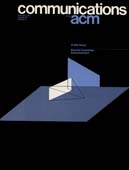February 1977 - Vol. 20 No. 2

Features
An approach to multidimensional data array processing by computer
Some recent work on the development of general-purpose computer-based statistical and data processing capabilities for handling multidimensional arrays of data is presented. Attention is first given to some of the general problems of multidimensional table and array processing. This is followed by a summary of some recent developments in array processing capabilities at the World Bank, in particular, the system identified as WRAPS (World Bank Retrieval and Array Processing System).
An empirical study of list structure in Lisp
Static measurements of the list structure of five large Lisp programs are reported and analyzed in this paper. These measurements reveal substantial regularity, or predictability, among pointers to atoms and especially among pointers to lists. Pointers to atoms are found to obey, roughly, Zipf's law, which governs word frequencies in natural languages; pointers to lists usually point to a location physically nearby in memory. The use of such regularities in the space-efficient representation of list structure is discussed. Linearization of lists, whereby successive cdrs (or cars) are placed in consecutive memory locations whenever possible, greatly strengthens the observed regularity of list structure. It is shown that under some reasonable assumptions, the entropy or information content of a car-cdr pair in the programs measured is about 10 to 15 bits before linearization, and about 7 to 12 bits after.
Convex hulls of finite sets of points in two and three dimensions
The convex hulls of sets of n points in two and three dimensions can be determined with O(n log n) operations. The presented algorithms use the “divide and conquer” technique and recursively apply a merge procedure for two nonintersecting convex hulls. Since any convex hull algorithm requires at least O(n log n) operations, the time complexity of the proposed algorithms is optimal within a multiplicative constant.
Transient-free working-set statistics
Transient-free average working-set size and transient-free missing-page rate for a finite sample of a reference string are defined. Use of these statistics is appropriate if the contents of the working set at the start of the recorded string are unknown. If a certain stationarity condition holds, these statistics provide unbiased estimates of expected working-set sizes, missing-page probabilities, and interreference distance probabilities. Two other pairs of estimators are shown to be biased. Expressions for the transient-free statistics are obtained in terms of interval statistics. Several methods of computation are discussed, the usefulness of each depending on length of the sample, number of distinct references, and the amount of main storage available to the computer performing the calculations. In particular, methods are described for handling long strings containing many distinct page names.
A linear algorithm for incremental digital display of circular arcs
Circular arcs can be drawn on an incremental display device such as a cathode ray tube, digital plotter, or matrix printer using only sign testing and elementary addition and subtraction. This paper describes methodology for producing dot or step patterns closest to the true circle.
Occurrences of cycling and other phenomena arising in a class of linear programming models
An investigation into the average queue size for a certain class of queues has resulted in the formulation of linear programming problems which are ill-conditioned in some cases. In attempting to solve these linear programming models, using IBM's MPS package, instances of cycling were encountered. Small perturbations in the input data resulted in problems which did not cycle. This fact, plus several other observed phenomena suggest that the primary reason that cycling is not known to occur more frequently is that round-off errors in the computations perturb the problem sufficiently to prevent cycling (or at least to prevent indefinite cycling). In one case maximizing and minimizing an objective function subject to the same constraint set was attempted, but MPS solved only one of these while giving an indication of infeasibility for the other.



